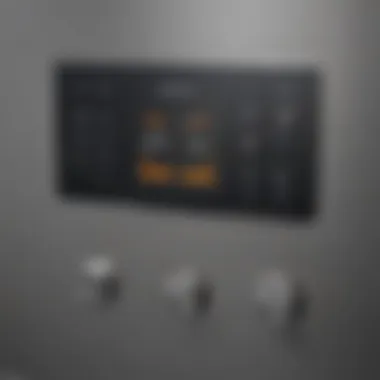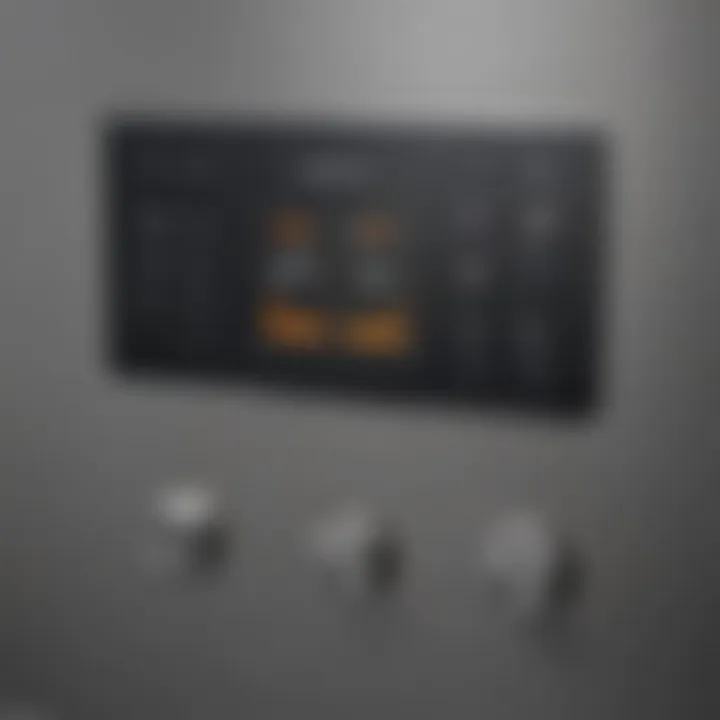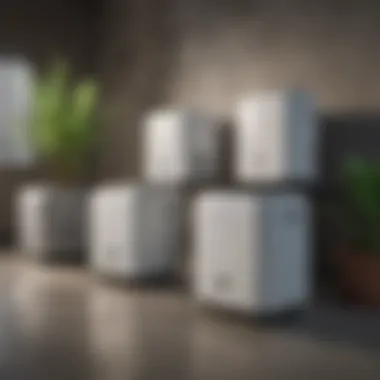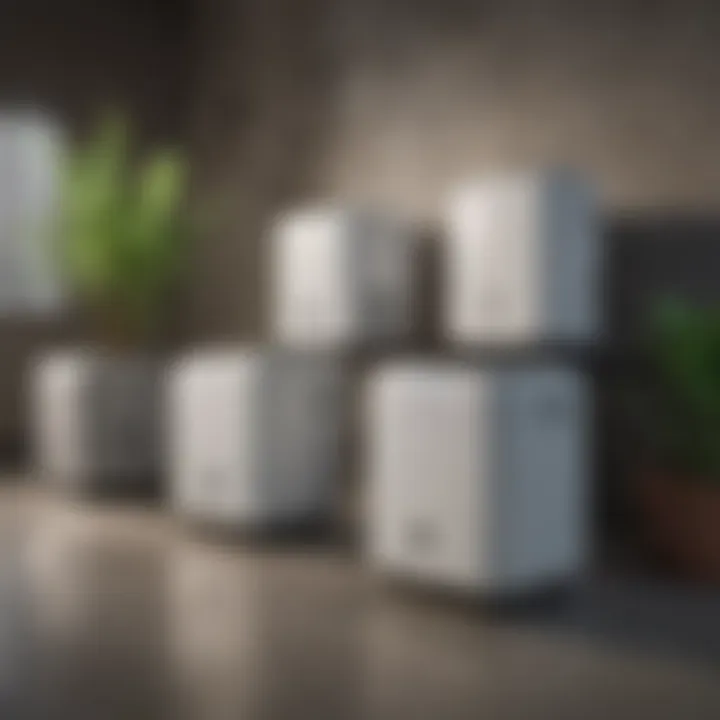Comprehensive Reviews of Air Dehumidifiers: An In-Depth Analysis


Topic Overview
Definition and Importance
Air dehumidifiers are devices designed to control humidity levels in indoor environments. They have become essential tools in many households, workplaces, and industrial settings. When humidity is too high, it can lead to discomfort, mold growth, and damage to materials and property. Conversely, maintaining optimal humidity levels can enhance air quality, promote health, and preserve the structural integrity of buildings. By removing excess moisture from the air, dehumidifiers help create a more pleasant living and working environment.
Brief History and Evolution
The concept of humidity control is not new. Historically, methods like ventilation and heating were employed to manage moisture in the air. However, with technological advancements in the 20th century, specialized devices like air dehumidifiers emerged. Early models were bulky and less efficient. Today, advancements in design technology and understanding of humidity control have led to more compact, silent, and energy-efficient units that cater to both residential and commercial needs.
Key Techniques and Innovations
Advanced Technologies in Dehumidification
Air dehumidifiers use several different technologies to manage moisture. The most common types include:
- Refrigerant Dehumidifiers: These work by cooling air, causing moisture to condense. This method is effective in warm environments.
- Desiccant Dehumidifiers: These utilize materials that absorb water vapor. They function well in colder conditions.
- Hybrid Models: Some modern units combine both technologies for versatility.
Recent innovations have optimized these systems for energy efficiency, ensuring that they consume less power while maintaining high performance.
Practical Applications
Step-by-Step Guide to Select the Right Dehumidifier
- Identify Your Space's Humidity Needs: Measure current humidity levels.
- Consider the Size of the Area: Larger spaces require units with greater capacity.
- Evaluate Energy Efficiency: Look for Energy Star rated models to save on electricity bills.
- Examine Features: Some units offer smart technology and remote control.
- Read User Reviews: Gather insights from other users to gauge performance.
The right air dehumidifier is not just a luxury; it is an essential item for managing indoor air quality.
Case Studies or Real-World Examples
- In a coastal region experiencing high humidity levels, homeowners noticed mold growth in basements. Installation of a refrigerant dehumidifier reduced humidity by 50% within weeks, effectively eliminating the mold issue.
- An agricultural facility utilized a large-scale desiccant dehumidifier to manage humidity in a seed storage warehouse, significantly prolonging the lifespan of stored seeds by reducing moisture-induced damage.
In summary, understanding the nuances of air dehumidifiers is vital for optimizing their use in various environments. As technology continues to evolve, these devices will only become more integral in managing humidity effectively.
Understanding Air Dehumidifiers
Air dehumidifiers play a crucial role in maintaining appropriate humidity levels, which is especially important in fields like agricultural management. Excess moisture can significantly affect crop quality and storage conditions. Understanding their functionality and types helps consumers make better choices adapted to their specific environment.
Proper humidity control contributes to preventing mold and mildew growth. These conditions can have detrimental effects not just on buildings but also on crops and products stored in moist environments. The insights offered in this article can guide readers, particularly farmers and enthusiasts, towards selecting the right dehumidifier that fits their requirements.
What is an Air Dehumidifier?
An air dehumidifier is a device designed to reduce and maintain the level of humidity in the air. It draws moisture from the atmosphere and either collects it in a tank or expels it outside. This reduction in humidity can lead to a healthier environment by preventing dampness which can harbor pests and diseases in agriculture settings. Dehumidifiers come in various shapes and sizes.
How Do Air Dehumidifiers Work?
Air dehumidifiers function by using one of several methods to remove moisture from the air. Most common methods include refrigeration and desiccation. In refrigeration, moist air is drawn into the unit and passed over cold coils. As the air cools, moisture condenses into water droplets, which then collects in a reservoir. Desiccant units utilize materials that absorb moisture directly from the air. They are best suited for areas with lower temperatures.
Types of Air Dehumidifiers
Different types of air dehumidifiers cater to various user needs and environments. Understanding these types helps consumers make informed decisions. Below are the main types of dehumidifiers:
Refrigerant Dehumidifiers
Refrigerant dehumidifiers are perhaps the most common. They use refrigeration technology to cool down the air, which causes moisture to condense. This type is well-suited for warmer environments, making it a popular choice in homes and commercial spaces.
One key characteristic of refrigerant dehumidifiers is their ability to lower the temperature of the air while dehumidifying it, providing comfort in humid conditions. However, these units can be less effective at lowering humidity in cooler climates.
- Advantages: Efficient in high-temperature environments, quick moisture removal.
- Disadvantages: Less effective in cooler conditions, higher energy consumption.
Desiccant Dehumidifiers
Desiccant dehumidifiers use hygroscopic materials to absorb moisture from the air. They are advantageous in lower temperatures and can be more efficient in drier climates. Many agricultural setups prefer this type for specific applications.
A unique feature of desiccant dehumidifiers is their ability to operate without cooling the air. This makes them suitable for areas where temperature control is not critical.


- Advantages: Works well in cooler settings, low energy costs.
- Disadvantages: Slower at removing moisture compared to refrigerant models.
Whole-House Dehumidifiers
Whole-house dehumidifiers are designed to regulate humidity levels throughout a home or larger space. They are typically installed as part of an HVAC system and can manage humidity levels in multiple rooms simultaneously. This aspect makes them ideal for larger agricultural buildings.
The main characteristic of whole-house dehumidifiers is their integrated systems that maintain consistent humidity. They can be a bit more complex to install and maintain but offer substantial benefits in overall comfort.
- Advantages: Comprehensive humidity control, energy-efficient if properly installed.
- Disadvantages: Higher initial costs, complex installation procedures.
By understanding the different types of air dehumidifiers, users can select one that fits their specific humidity management needs effectively.
Selecting the Right Air Dehumidifier
Selecting the right air dehumidifier is crucial for achieving optimal humidity levels in any environment. The correct unit not only enhances comfort but also protects property from damage caused by excessive moisture. A well-chosen dehumidifier can aid in reducing mold and mildew growth, thus promoting healthier indoor air quality.
Key considerations should involve room size, humidity levels, and energy efficiency. Understanding these elements ensures the selection meets both functional requirements and budget constraints.
Each factor relates directly to the dehumidifier’s effectiveness and efficiency, making their evaluation essential for achieving goals related to moisture control.
Factors to Consider
Room Size
Room size plays a significant role in determining the efficacy of an air dehumidifier.
A dehumidifier needs to cover the area it serves to function properly. For instance, a unit designed for small rooms may be ineffective in large spaces, resulting in inadequate moisture removal. This mismatch can lead to poor performance and increased energy consumption.
- Key Characteristic: The capacity to handle specific square footage determines how successful a unit will be in lowering humidity levels.
- Benefits: Choosing a dehumidifier that fits the room size can lead to lower energy use and more efficient moisture control.
- Disadvantages: Oversized units can lead to high energy costs and might cycle on and off more than necessary, leading to wear and decreased lifespan.
Humidity Levels
Monitoring humidity levels is another essential factor. Knowing the moisture levels in the environment aids significantly in selecting the right air dehumidifier.
High humidity levels can foster an uncomfortable living space and facilitate the growth of harmful mold. Therefore, understanding the current humidity will help guide the selection process.
- Key Characteristic: A dehumidifier's specifications often include its capacity to remove moisture measured in pints per day.
- Benefits: Selecting a unit that matches humidity levels allows for effective moisture management. Users can ensure the dehumidifier operates within optimal efficiency ranges.
- Disadvantages: Investing in a dehumidifier without accurate humidity readings can lead to over or under-purchasing, potentially wasting money.
Energy Efficiency
Energy efficiency is a crucial aspect when selecting an air dehumidifier due to long-term operation costs. Dehumidifiers consume energy; thus, an energy-efficient model can lead to significant savings.
- Key Characteristic: Models equipped with energy-saving features typically have higher initial costs but pay off in lower utility bills over time.
- Benefits: Choosing an energy-efficient model not only helps save on costs but also reduces the carbon footprint. This appeals to environmentally conscious users.
- Disadvantages: The cost of an energy-efficient dehumidifier may seem higher initially, but this should be viewed in the context of long-term savings.
Capacity Ratings
Understanding capacity ratings is essential for effectiveness in dehumidifying spaces. A unit’s capacity is generally expressed in pints of moisture removed in 24 hours. Different capacity models serve varied needs based on room size and humidity levels. A higher capacity typically signifies a larger area coverage or ability to eliminate more moisture daily.
Conclusively, selecting the right air dehumidifier requires evaluating room size, assessing humidity levels, and considering energy efficiency. These elements all play vital roles in achieving effective humidity control.
Comparison of Top Air Dehumidifiers
Analyzing different models of air dehumidifiers is crucial for informed purchasing decisions. Each model comes with its own set of features, performance metrics, and user experiences that are significant for potential buyers. The act of comparing top air dehumidifiers allows consumers to assess what specifications align best with their individual needs, taking into consideration factors such as efficiency, capacity, and maintenance requirements.
Understanding the strengths and weaknesses of models can lead to smarter investments, reducing long-term operational costs and optimizing functionality. This section provides an overview and comparison of three popular air dehumidifiers, spotlighting their specific features, performance, and user feedback. This analysis offers a comprehensive look into their practicality and suitability for various environments.
Dehumidifier A Overview
Features
Dehumidifier A comes equipped with state-of-the-art features that enhance its usability. One noteworthy aspect is its built-in humidistat, which monitors and automatically adjusts humidity levels. This function is pivotal as it reduces manual adjustments and maintains consistent air quality. Another key characteristic includes a washable air filter, promoting cleaner operation and making it a cost-effective choice for regular users. Moreover, its compact design allows for versatile placement in smaller spaces, meeting the demand for effective moisture control without consuming much area. Its ability to operate quietly adds to its appeal, making it suitable for bedroom use or office settings.
Performance
The performance of Dehumidifier A is rated highly among users. It can extract a substantial amount of moisture per day, proving effective even in high-humidity conditions. A unique feature is its energy-efficient mode, which optimizes power consumption while maintaining performance. This characteristic is particularly appealing for those who contribute to energy conservation efforts.
Users have noted that this model performs exceptionally well in basements or areas prone to excessive moisture, minimizing risk of mold and mildew significantly.


User Feedback
User feedback about Dehumidifier A emphasizes its reliability and effectiveness. Many reviews highlight the positive impact on air quality and comfort levels. The operation’s quietness is frequently praised, allowing for uninterrupted routines. However, some users mentioned its capacity might not suffice for larger spaces, indicating a potential limitation.
Dehumidifier B Overview
Features
Dehumidifier B is notable for its robust feature set, including an automatic shut-off function that activates when the tank is full. This safety measure saves users from potential overflow and damage. Another significant feature is its smart connectivity; it can be monitored and controlled via a smartphone app, which adds convenience for tech-savvy users. A unique design aspect includes a rotating humidistat dial, which appeals to those who prefer straightforward manual humidity control.
Performance
In terms of performance, Dehumidifier B does not disappoint. It boasts a competitive moisture extraction rate and operates efficiently in mid-sized rooms. Its ability to reduce humidity without excessive noise levels makes it suitable for daily usage. A unique offering is the continuous drain option, allowing for uninterrupted operation in high-demand environments, which further emphasizes its practicality for busy households.
User Feedback
User feedback shows a generally positive response to Dehumidifier B. Many users appreciate its smart features that enhance usability. However, some feedback points out that the app connectivity can be temperamental, which can frustrate users wanting seamless operation. Still, most users agree that it delivers substantial moisture reduction, justifying its investment.
Dehumidifier Overview
Features
Dehumidifier C distinguishes itself with a range of user-friendly features. One key aspect is its large capacity water tank, which reduces the frequency of emptying during use. This feature is beneficial for larger families or in high humidity areas. Additionally, it includes an adjustable fan speed, allowing users to customize operation based on current humidity levels. The function after a power outage is also a noteworthy enhancement, ensuring convenience during unexpected interruptions.
Performance
When evaluating performance, Dehumidifier C excels in moisture removal, particularly in sprawling spaces. Its advanced technology allows it to cover larger square footage effectively. A highlighted trait is its low temperature operation which permits efficient functioning in colder environments, a rarity among many models. However, it may consume slightly more energy compared to other models, which is a consideration for energy-conscious users.
User Feedback
Users of Dehumidifier C commonly express satisfaction with its efficiency and capacity. Many commend its effectiveness in larger spaces, addressing humidity issues effectively. Some negative feedback points to its bulkiness, making it less portable, but many users view its performance as a worthy trade-off. The favorable reviews solidify its position as a reliable choice for significant humidity control.
Energy Consumption and Cost-Efficiency
In the evaluation of air dehumidifiers, energy consumption and cost-efficiency are crucial factors that significantly influence both the operational expenditures and environmental implications of these devices. Understanding how much energy a unit consumes is paramount for consumers looking to manage utility bills while maintaining optimal humidity levels in their spaces. As air dehumidifiers can run for extended periods, their energy use can accumulate into substantial costs over time. Thus, analyzing efficiency ratings becomes essential for informed decision-making.
Understanding Energy Ratings
Energy ratings provide a transparent measure of how efficiently a dehumidifier operates. This rating typically takes into account both the energy used and the amount of moisture removed from the air, expressed in liters per kilowatt-hour (L/kWh) or pints per watt-hour (P/W). Higher energy efficiency ratings indicate that the device can remove more moisture using less power, which translates into lower electricity bills.
Here are some key factors regarding energy ratings:
- Energy Star Certification: Devices with this label meet stringent efficiency guidelines set by the U.S. Environmental Protection Agency.
- Seasonal Energy Efficiency Ratio (SEER): While more commonly associated with air conditioning units, this ratio can also indicate dehumidifier efficiency.
- Power Consumption: Understanding the nominal power draw during operation helps in calculating potential expenses.
Choosing a dehumidifier with a solid energy rating can lead to significant savings, making it more environmentally responsible.
Long-Term Cost Analysis
When considering the purchase of an air dehumidifier, the long-term costs extend beyond the initial price. This involves evaluating energy efficiency, maintenance costs, and potential replacements. A thorough long-term cost analysis provides deeper insights into overall expenditure.
Factors to consider include:
- Electricity Costs: Calculate expected monthly electricity costs based on your local rates and the dehumidifier's energy consumption.
- Maintenance and Repairs: Routine maintenance, such as filter replacements or tank cleaning, can incur additional costs.
- Longevity of the Unit: A higher-quality dehumidifier might cost more upfront but could offer longer service life and reduced repair needs.
"Investing in an energy-efficient air dehumidifier can lead to substantial savings over its lifespan, which justifies the higher initial expense."
By analyzing these elements, consumers can ascertain the worthiness of their investment based on both immediate and ongoing costs. This knowledge aids in selecting a product that not only fulfills humidity control needs but also aligns with fiscal responsibilities—important considerations for many homeowners and those in agricultural sectors.
Maintenance and Care
Maintaining a dehumidifier is crucial for ensuring optimal performance and longevity. Just like any other electronic device, regular maintenance helps prevent major issues and enhances the efficiency of the unit. Proper care involves a few straightforward tasks that can greatly influence how well the dehumidifier operates. This section will explore essential maintenance tasks and common issues that might arise, along with effective solutions.
Regular Maintenance Tasks
Regular maintenance tasks are essential to ensure that an air dehumidifier functions effectively. These tasks can often be done by the user and do not require professional help. Some key maintenance tasks include:


- Cleaning or Replacing Filters: Most dehumidifiers have filters that collect dust and allergens. Cleaning or replacing these filters every few weeks ensures that the airflow remains unobstructed. This not only improves the efficiency of the device but also helps get rid of molds and other allergens.
- Checking the Water Collection Bucket: Many models feature a water reservoir that needs to be emptied periodically. Check this bucket frequently to avoid overflow, which can activate an automatic shut-off feature, interrupting the dehumidification process.
- Cleaning the Coils: The evaporator and condenser coils accumulate dust and dirt over time. Regularly wiping these coils helps maintain their efficiency and lowers energy usage. This can be done by gently wiping with a cloth or using a brush specifically designed for this purpose.
- Inspecting Hoses: If the dehumidifier is designed to drain continuously through a hose, ensure the hose is clear of obstructions and is properly connected. Any blockage can lead to improper drainage and possible leaks.
- Checking for Mold and Mildew: Inspect both the water bucket and the interior of the dehumidifier itself for signs of mold or mildew. If detected, ensure thorough cleaning with appropriate solutions to prevent air quality issues.
By performing these maintenance tasks regularly, users can significantly extend the lifespan of their device and improve air quality in their environment.
Common Issues and Solutions
Users may encounter various issues with their dehumidifiers. Identifying and addressing these concerns promptly can prevent major malfunctions. Here are some common problems and their solutions:
- Unit Not Collecting Water: If the dehumidifier is not collecting water, check the humidity settings. If the humidity levels are already low, the unit may not need to operate as frequently. Additionally, inspect the filters for blockages.
- Excessive Noise: Unusual noises from the unit could signal a problem. Make sure the device is placed on a level surface. If the issue persists, it may be a malfunction of the fan or motor and might require professional attention.
- Water Leaks: Leaks can occur due to full water tanks or disconnected drain hoses. Regularly inspect the water reservoir and hoses, tightening connections as necessary.
- Frequent Cycling: If the dehumidifier turns off and on rapidly, it may be indicative of an issue with the humidity sensor or it may be struggling to meet the desired humidity levels. It is advisable to consult the manual for troubleshooting steps or to reach out to customer support.
- Foul Odors: Musty odors often indicate mold growth inside the unit. Cleaning the water bucket and components regularly should mitigate this issue. Using dehumidifier-specific cleaning solutions can also help.
Regular maintenance and prompt attention to common problems ensure a seamless experience with air dehumidifiers, maximizing their benefits in controlling humidity levels.
User Experiences and Testimonials
User experiences and testimonials play a vital role in understanding the effectiveness of air dehumidifiers. They provide insights that extend beyond technical specifications and laboratory results, offering a glimpse into how these devices perform in real-world conditions. This section delves into the significance of gathering qualitative feedback, which adds depth to the data analyzed in the previous sections.
Incorporating user feedback not only helps potential buyers make informed decisions but also highlights various practical benefits. Consumers often share how specific models addressed their humidity issues, which is particularly useful for those in comparable environments. Testimonials may reveal performance metrics that ratings alone may not capture, such as noise levels, ease of maintenance, and long-term durability. Additionally, every user has a unique context, influenced by factors like home size, climate conditions, and personal preferences. Thus, their experiences can shed light on the adaptability of particular dehumidifier models.
Case Studies
Case studies provide detailed examinations of how specific air dehumidifiers have performed in different settings. These comprehensive accounts can be particularly enlightening for consumers, revealing the strengths and weaknesses of diverse models under various conditions. For instance, consider a family residing in a coastal area with high humidity; their feedback on a refrigerant dehumidifier might focus on its ability to handle moist air efficiently. They may describe how they noticed a reduction in mold growth and improved air quality in their home.
Conversely, a farmer managing a greenhouse might emphasize the importance of maintaining optimal humidity levels for crop health. Their case study could demonstrate how a whole-house dehumidifier enhanced their agricultural output by controlling moisture levels, thus reducing plant disease.
User Ratings Summary
Sifting through user ratings becomes pivotal in assessing overall satisfaction with air dehumidifiers. These ratings usually appear on e-commerce platforms or specialized review sites, illuminating common themes. High ratings can indicate reliability and performance, while lower scores often highlight design flaws or inefficient operations. It's essential to analyze the distribution of ratings as well. For example, a product with an average score might mask polarizing reviews from users who either love or dislike the product.
A summary of user ratings may also reflect trends in particular features that stand out, like energy efficiency or portability. This information can guide users in prioritizing features that best meet their needs. In summary, the integration of user experiences and testimonials provides invaluable perspective, inviting readers to look beyond the numbers and into the realities of using these critical devices.
Environmental Impact of Dehumidifiers
The environmental impact of dehumidifiers is an essential aspect to consider when evaluating these devices. As air quality management becomes more important worldwide, particularly in agriculture, understanding the ecological footprint of dehumidifiers is crucial. The operation of these devices can significantly affect energy consumption, which in turn impacts carbon emissions and overall sustainability. Selecting dehumidifiers that are energy efficient contributes to reduced operational costs for farmers while promoting a healthier environment.
Energy Use and Carbon Footprint
Energy consumption is a vital factor in determining the environmental footprint of dehumidifiers. Most air dehumidifiers operate using either refrigerant or desiccant technology. Each method has different energy requirements and efficiencies. Refrigerant dehumidifiers tend to require more energy during operation due to their cooling components. In contrast, desiccant models often use less energy because they rely on moisture-absorbing materials.
"Energy use is not just about consumption; it influences the carbon footprint of agriculture significantly."
When assessing the carbon footprint of dehumidifiers, it is essential to look at the source of the energy being used. For example, electricity generated from fossil fuels increases greenhouse gas emissions. Alternatively, renewable energy sources can lessen this impact. Selecting dehumidifiers that offer high energy efficiency ratings, such as Energy Star certified models, can help reduce overall electricity consumption and, by extension, the carbon footprint of farming operations.
Sustainable Practices
Implementing sustainable practices when using air dehumidifiers is essential to minimize their environmental effects. Farmers can adopt several strategies to ensure efficient use of technology while reducing waste. Here are some practices to consider:
- Regular Maintenance: Keeping dehumidifiers in optimal working condition will improve efficiency, prolong their lifespan, and reduce energy waste.
- Proper Sizing: Choosing a dehumidifier suitable for the specific space reduces unnecessary energy use. Oversized units typically use more energy than necessary, leading to greater inefficiencies.
- Integration with Climate Control Systems: Coordinating dehumidifier use with existing climate control systems can enhance performance and efficiency, ensuring that devices operate only when required.
- Utilizing Renewable Energy Sources: Where possible, connecting dehumidifiers to renewable energy sources can significantly lower the carbon footprint. Solar panels, for example, can provide a sustainable power supply for these machines.
By focusing on these practices, farmers and enthusiasts can reduce the negative environmental impacts associated with dehumidifiers. Emphasizing energy-efficient solutions not only promotes sustainability but also fosters better agricultural productivity, creating a balance between technology and ecological responsibility.
Closure and Recommendations
In the current discourse on humidity control, the significance of air dehumidifiers cannot be overstated. These devices play a critical role in maintaining comfortable and healthful indoor environments, particularly in areas prone to excessive moisture. As this article illustrates, selecting the appropriate air dehumidifier requires careful consideration of numerous factors.
This section serves to synthesize the insights acquired throughout the article and offer actionable recommendations. By understanding the various functionalities of different models, users can evaluate which product aligns best with their specific needs. Key factors include room size, personal humidity preferences, and energy consumption rates. Properly assessing these elements can dramatically enhance comfort while minimizing detrimental effects associated with high humidity.
Summary of Findings
The thorough review of air dehumidifiers reveals several noteworthy conclusions. Notable findings include:
- Diverse Product Range: The market offers a variety of air dehumidifiers, each suited for distinct applications, from personal space units to whole-house solutions. This diverse range ensures that consumers can find the right equipment.
- Performance Variability: Performance metrics vary significantly according to model and manufacturer. This necessitates an examination of features like extraction rate, noise levels, and usability.
- User Feedback: Genuine user testimonials provide invaluable insights. Reviews highlight both the strengths and weaknesses of products, aiding prospective buyers in making informed decisions.
- Energy Efficiency: Understanding energy ratings is essential, especially for those concerned about long-term operational costs. Efficient models may have higher upfront costs but can lead to savings on energy bills.
Final Thoughts on Choosing an Air Dehumidifier
When contemplating the purchase of an air dehumidifier, it is vital to adopt a measured approach. Begin by assessing the unique conditions of your environment. Consider aspects like:
- Humidity Levels: Use a hygrometer to obtain accurate measurements of indoor humidity. This will guide you in choosing a model with suitable capacity.
- Room Specifications: Measure the square footage of the intended area. Different models cater to various room sizes; ensure compatibility to optimize performance.
- Required Features: Determine necessary functionalities such as auto shut-off, continuous drainage options, and humidity settings. Identifying must-have features will clarify the decision-making process.
An informed choice entails more than simply selecting the most popular product. Rather, it requires a comprehensive understanding of individual requirements and the ability to assess various options available. Investing time in research ensures that your selection not only meets immediate needs but also contributes to overall long-term satisfaction.
"The right air dehumidifier can profoundly affect indoor air quality, comfort, and health. Choose wisely."
By amalgamating findings and highlighting essential considerations, this article aims to empower readers to navigate the intricate world of air dehumidifiers with confidence.



